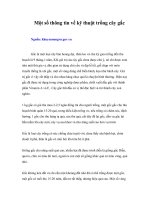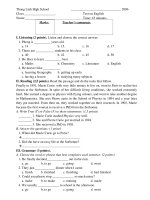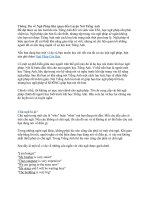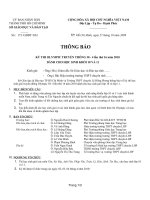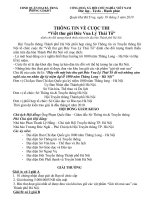Key english test for school Thông tin về kỳ thi KET for School
Bạn đang xem bản rút gọn của tài liệu. Xem và tải ngay bản đầy đủ của tài liệu tại đây (1.35 MB, 16 trang )
Information for Candidates
Key
English
Test for Schools
ket for schools information for candidates 2
Why take the Key English Test (KET)
for Schools?
Success in the Key English Test (KET) for Schools shows that you have a basic
understanding of everyday English.
The content and topics in the test are targeted at the interests and experiences of school
children.
You are tested in reading, writing, listening and speaking.
n International recognition
KET for Schools is at Level A2 of the Common European Framework of Reference (CEFR).
Level A2 shows that the learner can, for example:
understand simple questions and instructions•
express simple opinions or needs•
complete forms and write short, simple letters related to personal information.•
KET is recognised as a qualification in basic English by organisations and educational
institutions across the world.
You can find a full list at: www.CambridgeESOL.org/recognition
n Certificates
Learners who pass KET for Schools receive a certificate showing they have passed the Key
English Test at Level A2.
Learners who show ability at the level below A2 are awarded a certificate showing they
have achieved Level A1 of the CEFR.
For more information about KET for Schools, please visit:
www.CambridgeESOL.org/KETforSchools
Why take a Cambridge ESOL test?
Cambridge ESOL is a part of Cambridge Assessment, which has over 150 years’ experience
in educational assessment.
We are committed to providing internationally recognised qualifications that help you to
achieve your life goals.
For more information about Cambridge ESOL, please visit: www.CambridgeESOL.org
Information
for candidates
– KET for
Schools
ket for schools information for candidates 3
What does KET for Schools involve?
This booklet is a brief introduction to KET for Schools. We show examples from each part
of the test, but in some cases we do not show the full text or all the questions. If you would
like to see a full sample paper for KET for Schools, you can download one from our website
at: www.candidates.CambridgeESOL.org/cs/
The table below shows the different parts of KET for Schools and how long each paper
takes. In KET for Schools, Reading and Writing are combined on one question paper.
Name of paper Content Time allowed Marks (% of total)
Paper 1
Reading and Writing
9 parts / 56 questions
Reading: Parts 1–5
Writing: Parts 6–9
1 hour 10 minutes 50%
Paper 2
Listening
5 parts / 25 questions 30 minutes
(including 8 minutes’
transfer time)
25%
Paper 3
Speaking
2 parts 8–10 minutes per pair
of candidates (2:2
format*)
25%
* 2 examiners, 2 candidates (2:3 format is used for the last group in a session where necessary)
n Paper 1 Reading and Writing
Time: 1 hour 10 minutes
Paper 1 Reading and Writing consists of nine parts and 56 questions. It is worth 50% of the
total marks for the exam.
Reading
Part 1 (Questions 1–5)
In this part you have to understand the main message of a sign, notice or other very short
text. These texts are usually the kind of text you can find on roads, in railway stations,
shops, cafés, schools, etc. There are also five sentences and you have to match each
sentence to one of the texts.
In the example on the next page you have eight signs (labelled A–H) and five sentences
which explain what the signs mean. You have to match each sentence to the right sign.
ket for schools information for candidates 4
Part 2 (Questions 6–10)
This part is a test of vocabulary. You have five sentences and there is a missing word in
each one. There are three possible answers and you have to choose the best word to fill
each gap.
The examples below are sentences about an internet café. Read the sentences and decide
which answer (A, B or C) is the correct one. In the test, there are two more questions like
the ones below.
ket for schools information for candidates 5
Part 3 (Questions 11–15 and 16–20)
In this part we test how well you understand and can use the language you need for
everyday life. The first five questions are short conversations. The question is what the first
person says and you then have three possible responses. To find the right answer, you have
to think what the second person usually says in this situation.
In the example below, there are three typical questions (11–13). For each question, you
have to choose the correct answer (A, B or C). In the test, there are two more questions
like this.
The second five questions are part of a longer conversation which has missing sentences.
The conversation may take place in a shop, a school, a café, etc. or in various social or
study situations.
In the conversation below, Josh is talking to Matt, and you have to decide what Josh says
in each case (16–18). You have a list of eight possible sentences (A–H) which you can use to
complete the conversation. You have to choose one sentence for each space, so you don’t
need all of the sentences.
ket for schools information for candidates 6
Part 4 (Questions 21–27)
This part consists of a longer text (about 230 words) and seven questions. These may
be multiple-choice questions with three possible answers (A, B or C) or you may have
seven statements and you have to decide if each statement is A – Right, B – Wrong or
C – Doesn’t say.
In the example below, you have to read the article about a young swimmer from Australia.
For each of the statements (21–23), you have to decide if it is Right (A), Wrong (B) or if you
can’t find the information in the text, you should choose C (Doesn’t say). In the test, there
are four more questions like these.
Part 5 (Questions 28–35)
In this part you have to show that you understand and can use English grammar correctly.
There is a text for you to read, but some of the words are missing. These can be verb forms,
prepositions, conjunctions, pronouns, etc. For each missing word, there are three possible
answers and you have to choose the right one.
The example on the next page is an article about a circus with three sets of answers
(28–30). You have to choose the best word (A, B or C) for each space. In the test, there are
five more sets of answers like these.
ket for schools information for candidates 7
Part 6 (Questions 36–40)
The focus of Parts 6–9 of Paper 1 is on writing.
This part is about vocabulary. You have to find the right word for something and spell it
correctly. All five words will be from the same topic, for example, hobbies, food, things
you can find in a house, etc. For each word you have to find, there is a definition in simple
English and we give you the first letter of the word to help you.
In the example below, there are some descriptions of things people like to do in their free
time and you have to find the correct word being described. After each sentence, we give
you the first letter of each word you have to find. We also show you how long the word is
by giving you a dash (_) for each of the remaining letters in the word. In the test there are
two more questions like the ones below.
Part 7 (Questions 41–50)
This part tests grammar and vocabulary. You have to read a short text which may be a
note, and a reply to that note. It may also be a single letter. In the test there are some
missing words and you have to find the right word to fill each space. You must spell the
words correctly.
In the example on the next page, a girl from Mexico City has left a message on the
internet. Read the message and try to find the missing words for the spaces (41–50).
ket for schools information for candidates 8
Part 8 (Questions 51–55)
In this part we test reading and writing. You have to read one or two short texts (note,
email, advertisement, etc.) and use the information to fill in a form, diary entry or other
similar document.
The example below is about an ice-skating party. You have to read the invitation from Sara
and the email from Carla. Then you have to complete Louisa’s notes (questions 51–55).
ket for schools information for candidates 9
Part 9 (Question 56)
For the last part of Paper 1 you have to write a short message (25–35 words). This could be a
note or an email to a friend. The instructions tell you who you are writing to and what type
of message to write.
In the example below you have to write a note to a friend about visiting their house.
Remember to respond to all of Alex’s questions.
ket for schools information for candidates 10
n Paper 2 Listening
Time: approx. 30 minutes including 8 minutes’ transfer time
In the Listening paper there are five parts and 25 questions. The types of exercises you
will have to do are: multiple choice, gap-filling and matching. The texts you will hear are
monologues and dialogues, including interviews, discussions, telephone conversations and
messages. You will hear each conversation twice. The Listening paper is worth 25% of the
total marks.
Part 1 (Questions 1–5)
In this part you will hear five separate short conversations. The conversations are either
between friends or relatives, or between a member of the public and a shop assistant, etc.
You have to listen for information like prices, numbers, times, dates, locations, directions,
shapes, sizes, weather, descriptions of people and current actions. For each question there
are three possible answers which are pictures or drawings.
Below you can see two questions from a test paper. You have to read the question, listen
to the recording and choose the right answer (A, B or C). In the test, there are three more
questions like the ones below.
Part 2 (Questions 6–10)
In this part you will hear a longer conversation and you have to identify simple factual
information. The conversation is between two people who are talking about things such as
daily life, school or free time. You have to listen to the conversation and match the words
on two lists to each other. For example, you may have a list of names and a list of food.
When you listen to the recording you will hear what food each person likes to eat.
In the example on the next page, Nick is talking to a friend about his birthday presents.
You have to listen to the recording and write down which present each person gave him.
There is a list of people (6–10) and a list of different presents (A–H). You have to write the
correct letter next to each person. You have to choose one present for each person so you
won’t need to use all the presents.
ket for schools information for candidates 11
Part 3 (Questions 11–15)
In this part of the Listening test you will hear an informal conversation between two
people. You have to listen to factual information to answer the questions. There are five
questions and each question has three possible answers.
In the example below, Susie is talking to Matt about going to the cinema. You have to listen
to the recording and choose the correct answer (A, B or C) for each question (11–13). In the
test, there are two more questions like the ones below.
ket for schools information for candidates 12
Part 4 (Questions 16–20)
In this part of the Listening test, you have to listen to a dialogue and write down some
information. The dialogue takes place in an informal or neutral context, for example a
shop or a classroom. After you listen to the recording, you have to complete a message or
note on the question paper with the information you have heard. This may be numbers,
dates, prices, spellings and words.
In the example below, the recording is of a girl asking a friend about guitar lessons. You
have to write down the missing information for questions 16–20. For each question, you
have to write one or two words or numbers.
Part 5 (Questions 21–25)
Part 5 is similar to Part 4 but it is a monologue. It may be a recorded message.
In the example on the next page, you hear some recorded information about a new TV quiz
show. You have to fill in the missing information for questions 21–25. You have to write one
or two words or numbers in each space.
ket for schools information for candidates 13
At the end of the paper-based version of the Listening test, you have 8 minutes to transfer
your answers to the answer sheet.
ket for schools information for candidates 14
n Paper 3 Speaking
Time: 8–10 minutes per pair of candidates
For the Speaking test there are two oral examiners and you take the test in a pair with
another candidate. At centres with an uneven number of candidates, the last single
candidate is examined with the last pair in a group of three. The Speaking test is worth
25% of the total marks.
Part 1
The first part of the test takes 5 to 6 minutes and you have to show that you can use the
English you need when you meet someone for the first time. One of the examiners will talk
to you and you will have to give personal information (for example, your name and where
you come from) and talk about your daily life, interests, likes, etc.
Part 2
This part takes 3 to 4 minutes and you have to talk to the other candidate. The examiner
will give you a prompt card like the one below and you have to ask and answer questions.
In the example below, Candidate A has some information about a skateboarding
competition and Candidate B has a card with some question prompts. Candidate B has to
use the prompts and ask some questions about the competition. After 4 or 5 questions, the
examiner will stop your conversation and give out two new prompt cards with different
information. This time Candidate A has to ask questions and Candidate B has to answer.
ket for schools information for candidates 15
Preparing for KET for Schools
If you would like more practice material to help you prepare for KET for Schools, there are
past paper packs available to buy which include an audio CD of the Listening test. You can
find more information, prices and details on our website at:
www.CambridgeESOL.org/resources/past-papers.html
Next steps
We wish you every success in taking KET for Schools and we hope that you will take other
Cambridge ESOL tests in the future. The Preliminary English Test (PET) for Schools is the
next level of Cambridge tests. You can find more information about PET for Schools on our
website at:
www.CambridgeESOL.org/PETforSchools
ket for schools information for candidates 16
3M
Adidas
Agfa-Gevaert
AstraZeneca
AT&T
Barclays Bank
BASF
Bayer
BP
British Airways
Cable & Wireless
Carrefour
Citibank
Coca-Cola
Colgate-Palmolive
Credit Suisse
DaimlerChrysler
Dell
Deutsche Bank
DHL
Disney
DuPont
Ericsson
Estée Lauder
General Motors
Gillette
GlaxoSmithKline
Goodyear
Hertz
Hewlett-Packard
HSBC
IBM
Johnson & Johnson
KPMG
Microsoft
Mobil Oil
Nestlé
Nokia
PepsiCo
Philips
PricewaterhouseCoopers
Procter & Gamble
Rank Xerox
Roche
Rolls-Royce
Shell
Siemens
Sony
Sun Microsystems
Texaco
Toyota
Unilever
Vodafone
World Bank
World Health Organization (WHO)
World Wide Fund for Nature (WWF)
Companies
who recognise
Cambridge
ESOL exams
www.CambridgeESOL.org/KET
University of Cambridge
ESOL Examinations
1 Hills Road
Cambridge
CB1 2EU
United Kingdom
Tel. +44 1223 553355
Fax. +44 1223 460278
For a full list of companies and educational institutions who recognise KET, please visit our
website at:
www.CambridgeESOL.org/recognition
© UCLES 2009 EMC | 6000 | 9Y06 NOT FOR RESALE
*8263272463*

